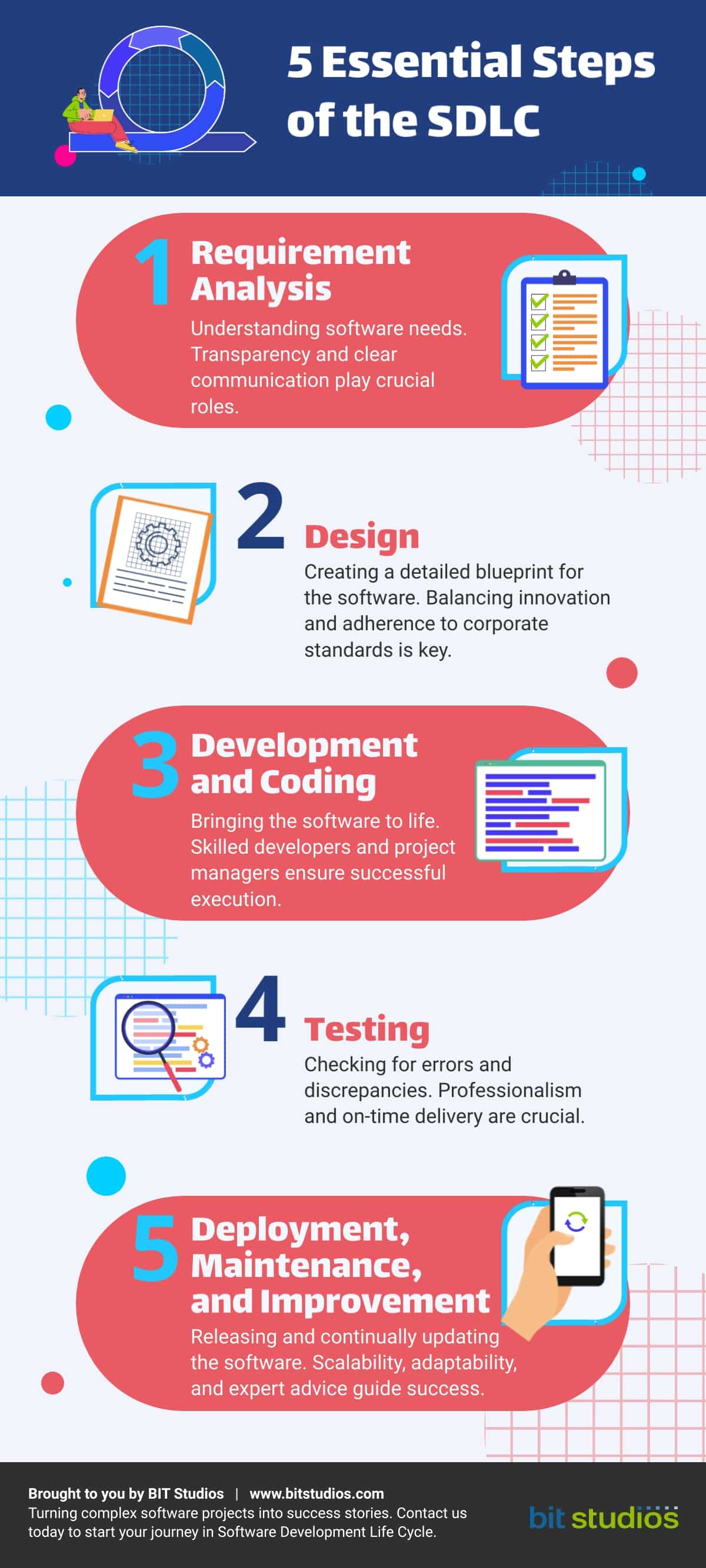Software Development Life Cycle
5 Essential Steps to Project Success

Software development is a complex process that requires a structured approach to ensure project success. Understanding the Software Development Life Cycle (SDLC) is crucial in navigating this intricate journey.
SDLC is a systematic method to conceptualize, design, develop, test, deploy, and maintain software systems. This article discusses each step of the SDLC, showing how it contributes to a successful project.
Also, we’ll talk about how the SDLC can be tailored to fit different business needs, from highly regulated industries to fast-paced startups. We’ll guide you in choosing the right software development partner and provide real-life case studies highlighting the power of a well-implemented SDLC.
Whether you’re new to software development or an experienced professional seeking to refine your process, this comprehensive guide offers valuable insights to enhance your journey. Let’s delve in and unlock the potential of the SDLC!
Understanding the Software Development Life Cycle
SDLC is like a roadmap or a guide, providing steps to follow when creating a software product.
Definition and Purpose of the SDLC
The SDLC is a structured process including different stages, from an idea for a software product to its creation, testing, deployment, and maintenance. The primary purpose of the SDLC is to ensure high-quality software that meets the customer’s needs. Moreover, it aims to complete the project on time and stays within the planned budget. The SDLC helps predict and manage possible risks and challenges. Thus, it makes completing the software development project easier.
Importance of Following the SDLC for Project Success
Following the SDLC is crucial for the success of a software development project. Each phase of the SDLC has a specific goal and a set of tasks to achieve this goal. By adhering to the SDLC, developers can understand what to do, when, and how. This clear direction reduces confusion, missteps, and rework, saving time and resources. In addition, it allows for ongoing check-ins to ensure the project is on the right track.
General Benefits and Importance of the SDLC for All Organizations
SDLC is not just vital for software developers. It also benefits all organizations that use the software in their operations. Here are just a few reasons why:
1. Quality
The SDLC ensures the final product is high quality, free of bugs, and meets user needs.
2. Cost and Time Effective
By reducing the risk of project failure and the need for rework, the SDLC helps save time and money.
3. Risk Management
The SDLC helps find and solve potential problems early through ‘risk assessments.’
4. User-Centric
With a focus on user needs and feedback at every stage, the SDLC ensures the final product is user-friendly and efficient.
5. Maintenance and Improvement
The SDLC doesn’t stop at deployment. It includes maintenance and improvements, ensuring the software continues to serve its purpose over time.
Ultimately, SDLC is an essential framework in the software development process. It guides developers in creating high-quality software and is a valuable tool for all organizations that rely on software.
5 Crucial Phases in the Software Development Life Cycle (SDLC)

SDLC consists of five essential steps: concept, design, development, testing, and deployment. Let’s explore each step in detail.
1. Requirement Analysis
Requirement analysis sets the foundation for the entire project. It’s about understanding what the software needs to do. During this phase, project stakeholders, such as customers, users, or company executives, communicate their needs and expectations for the software. It could include specific features, performance levels, and how it should interact with other systems.
Explanation of Requirement Analysis, Its Importance, and How It Is Conducted
In requirement analysis, project stakeholders and the development team discuss and document what the software should achieve. It involves interviews, surveys, and observing users in their work production environment to understand their needs. Once you have created a clear, detailed software requirement specification document, it becomes the reference point for all future work.
The Role of Transparency and Clear Communication in Requirement Analysis
Transparency and clear communication are critical in requirement analysis. All stakeholders must communicate their needs and expectations openly and clearly. Misunderstandings or ambiguities at this stage can lead to problems later, like the software not meeting user needs or going over budget. Thus, everyone involved needs to ensure they’re clear and understood.
2. Software Design
In the design phase, the development team creates a detailed plan or blueprint for building the software according to the requirements gathered in the first step.
Overview of the Design Phase, Its Importance, and the Key Activities Involved
During the design phase, the focus is on how the software will work and what it will look like. The design team decides on the software’s structure, the technologies to use, and how different components will interact. They create design documents with diagrams and instructions to guide the developers in the next phase.
This phase is critical because a well-planned design leads to efficient coding, easier testing, and a software product that meets user needs. It’s like having a detailed plan before constructing a building, ensuring everything will fit together correctly.
The Need for Innovation and Adherence to Corporate Standards in This Phase
Innovation during the design phase is essential to develop creative solutions to meet users’ needs and make the software more efficient and user-friendly. It could involve using new technologies, creating intuitive user interfaces, or finding innovative ways to handle data.
At the same time, the design must adhere to corporate standards. The organization sets these rules to ensure consistency, security, and compatibility with other systems. For example, there might be standards for storing data or designing user interfaces. Following these standards makes it easier to maintain and update the software in the future.
3. Development and Coding
The development and coding phase is where the actual creation of the software takes place based on the design made in the previous step.
Brief About the Development Phase, Its Significance, and What It Entails
In the development phase, the software comes to life. Developers write code using programming languages like Python, Java, or C++, depending on what’s best for the project. This code is like a set of instructions that tell the computer what to do.
The developers create databases to store data, implement the software’s functionalities, and ensure that different software parts can communicate. Everything planned in the design phase gets translated into working software during this phase.
This phase is significant because it’s when the software product becomes a reality. All the planning and designing done in the previous steps have come to fruition.
Importance of Skilled Developers and Project Managers in This Stage
Developing software requires a high level of skill and expertise. Skilled developers are needed to write efficient and error-free code. They need to understand the design, the programming language, and how to solve problems that may arise.
Project managers also play a critical role in this phase. They ensure that the development work stays on track, is completed on time, and stays within budget. They coordinate with the development team, solve issues, and inform everyone about the project’s progress. Their role is crucial to ensure the successful execution of the development phase.
4. Software Testing
Testing is a critical phase where the software is carefully checked for errors, issues, or discrepancies.
Explanation of the Testing Phase, Why It’s Crucial, and What It Involves
Testing is all about making sure the software works as it should. The testing team uses various methods to check if the software functions correctly, is user-friendly, and is secure. They look for any problems or errors in the code that might prevent the software from working correctly.
In this phase, the software is put through different types of tests. For example, functional testing checks if the software’s features work as expected. Performance testing assesses if the software can handle heavy loads or work quickly. Security testing checks if the software is safe from threats.
Testing is crucial because it ensures the final software product is reliable, user-friendly, and error-free. Without thorough testing, the software may have problems that could lead to user dissatisfaction or even security breaches.
The Role of Professionalism and On-Time Delivery in This Phase
The testing phase requires a high level of professionalism. The testing team must be meticulous and disciplined, as overlooking even a single error can have serious consequences. They must proficiently use different testing tools and techniques and document their findings.
On-time delivery is also crucial in this phase. The testing phase must be completed within the scheduled time to ensure the project remains on track. Any delays in testing can lead to delays in the following stages, like deployment and maintenance, which can impact the project’s success.
5. Software Deployment, Maintenance, and Improvement
Deployment, maintenance, and improvement happen when developers release the software to users and then continually update and improve it.
Overview of the Deployment, Maintenance, and Continual Improvement Phase, Its Importance, and What It Requires
In the deployment phase, the software is available for users to install and use. It might be launched on an app store or website or installed directly onto users’ devices or servers.
After deployment, the maintenance phase begins. It involves updating the software, fixing any bugs that might arise, and ensuring the software continues to function smoothly. Also, developers can improve the software based on user feedback or changing requirements.
This phase is essential because it ensures the software remains valuable and efficient over time. It requires ongoing work from the development team to keep the software up-to-date and problem-free.
The Intricacies Involved: Software Installation, Interoperability Checks, User Training, Systematic Updates, and Troubleshooting
In this phase, developers should complete several intricate tasks. They must install the software correctly and conduct interoperability checks to ensure it works well with other systems. User training might be necessary to help users understand how to use the software effectively.
Systematic updates are crucial to incorporate new features or fix bugs, and troubleshooting is required to resolve any issues users might encounter while using the software.
How Scalability, Adaptability, and Expert Advice Can Play a Critical Role in This Phase
Scalability, adaptability, and expert advice are vital in this phase. The software should be scalable and handle more users or data as needed. It should also adapt to changing user needs or technological advancements.
Expert advice is often necessary to guide these improvements, solve complex issues, and ensure the software continues to meet users’ needs effectively. The development team’s expertise plays a crucial role in the success of this phase.
How to Adapt SDLC to Different Business Needs
SDLC is flexible and can be adapted to meet the specific needs of different businesses and projects. Just like each business is unique, each software project has special requirements. Depending on the type of project, its size, timeline, and industry, the SDLC’s steps can be adjusted. Some projects require more time in the design phase, while others focus more on testing. This flexibility allows the SDLC to provide a structured software development approach tailored to any project’s needs.
Highly Regulated Industries
SDLC serves highly regulated industries that need extra safeguards against security or privacy breaches. In these cases, organizations must adhere strictly to the SDLC’s steps, which involve additional measures like external audits or compliance checks.
- Understanding the Constraints
In industries like healthcare and finance, many strict rules, known as regulations, must be followed. Highly regulated industries need to ensure the security and privacy of sensitive information. Also, the development team should use specific technologies, tools, or programming languages compliant with industry standards.
- Adapting SDLC for Compliance
When developing software for these industries, developers must adapt the software development life cycle to comply with these regulations. It may include additional checks or measures to ensure security and privacy.
- Case Example: Healthcare
For instance, in healthcare, software must adhere to regulations such as HIPAA in the United States. It means special attention is given to data encryption and privacy during the SDLC to protect patients’ medical information.
Fast-Paced Industries
Some industries move and progress quickly, like tech or gaming. Software development must be agile to meet user needs and industry trends. In these cases, the SDLC should be flexible enough to adapt quickly and incorporate new features or technologies whenever needed.
- The Need for Speed and Flexibility
Fast-paced industries like tech startups require rapid, flexible software development due to rapidly changing technologies and customer needs.
Agile and Scrum methods are often used in the software development life cycle to foster flexibility and efficiency. Agile allows quick adaptation to changes, and Scrum ensures structured task management.
- Case Example: Tech Startups
For example, a tech startup developing a new app might use Agile to rapidly implement user feedback and Scrum to manage development tasks, ensuring timely product delivery efficiently.
Complex Long-Term Projects
Long-term, complex projects, like those for enterprise apps, require structured planning and clear communication between stakeholders. The SDLC should enable efficient task management and quick adaptation to changes.
- Challenges in Long-Term Projects
Long-term software projects present unique challenges. These can include managing evolving requirements over time, coordinating large teams, and maintaining system quality over a lengthy development period.
- Role of Iterative and Incremental SDLC
Developers can use an iterative and incremental approach in the SDLC to handle these challenges. This approach breaks down the project into smaller parts and allows for regular evaluation and gradual improvements.
- Case Example: Large Enterprise Systems
For instance, over time, an extensive banking system might be developed incrementally, starting with core banking features and adding additional modules like online banking, mobile banking, etc. This approach allows for systematic system development, testing, and improvement.
Simple Short-Term Projects
Simple, short-term projects often require rapid development to meet tight deadlines. The SDLC should emphasize speed and efficiency for quick product delivery.
- Simplifying the SDLC
Simple, short-term projects often require a streamlined software development life cycle to deliver quick results. It involves simplifying steps to save time and resources.
- Lean and Rapid Application Development (RAD)
You can use methods like Lean and RAD to make the SDLC more efficient. Lean minimizes waste, while RAD emphasizes rapid development and frequent user feedback.
- Case Example: MVPs for Startup
For example, a tech startup might want to quickly build a minimum viable product (MVP), a basic version of their software. They could use Lean to minimize wasted effort and RAD to promptly incorporate user feedback, improving their MVP swiftly and efficiently.
Choosing the Right Software Development Partner
Here are some steps to help you choose the right software development partner:
1. Select One With the Right Expertise and Experience
Finding the right skills and experience for your specific project and industry is crucial when choosing a software development partner. They should understand your needs and be familiar with the challenges you might face.
2. Collaborate With One Who Can Adapt the SDLC to Your Specific Needs and Constraints
Your partner should be flexible enough to adapt the SDLC to fit your project’s requirements and limitations.
3. Ensure the Partner Can Provide Ongoing Support, Maintenance, and Improvement Services
A good partner will offer continuous support, maintenance, and improvements after developing the software, ensuring its long-term success.
4. Evaluate the Partner’s Track Record
Look at your potential partner’s past work, client feedback, and detailed case studies to assess their capability and reliability to deliver successful projects.
5. Consider Cost-Effectiveness, Communication Styles, Cultural Fit, and Project Management Methodologies
Review cost, communication style, how well they fit your organization’s culture, and project management methods. These elements can significantly influence the success of your project.
Case Studies: Successful Application of the SDLC
SDLC has been applied successfully in many different types of projects. Here are a few examples:
- Real-Life Examples of Projects That Benefited From Well-Implemented Development Practices
1. Microsoft
Microsoft utilizes a combination of SDLC principles and Agile methodologies in its software development processes. For example, their development of the Windows operating system involves iterative development cycles and frequent updates, enabling them to adapt to user feedback and technology trends.
2. Spotify
Spotify’s success is attributed to its Agile and Scrum methodologies, which emphasize flexibility, rapid development cycles, and frequent releases. These practices enable them to continuously deliver new features, respond to user feedback, and adapt to the fast-paced music streaming industry.
- Lessons Learned and How To Take Advantage of Them
1. Iterative Development
Breaking down development into smaller cycles (sprints in Agile) allows for continuous improvement, faster feedback loops, and better adaptation to changing requirements.
2. Agile and Scrum Methodologies
These frameworks promote flexibility, collaboration, and rapid iteration, enabling teams to respond quickly to changes in user needs or market trends.
3. Continuous Delivery/Deployment
Regularly releasing new features or updates keeps software relevant and engaging for users. It also allows for faster feedback and validation of new ideas.
Conclusion
This article covered the software development lifecycle, its five essential steps, and how it can be adapted to different industries and projects.
Correctly implementing the SDLC process is essential for successful software development, as it helps manage projects effectively and ensures high-quality results. Understanding the SDLC phases will remain a valuable skill as technology evolves. If you need professional help with your software projects, don’t hesitate to consult with BIT Studios. We can provide expertise and services that align with your specific needs. Contact us today!
We’re BIT Studios!
At BIT Studios we specialize in designing, building, shipping, and scaling beautiful, usable products with blazing-fast efficiency



